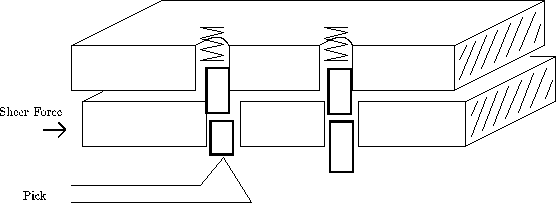Chapter 4: Basic Picking & The Binding Defect
Chapter 4
Basic Picking & The Binding Defect
The flatland model highlights the basic defect that enables lock
picking to work. This defect makes it possible to open a lock by
lifting the pins one at a time, and thus you don't need a key to lift
all the pins at the same time. Figure 4.1-4.3 shows
how the pins of a lock can be set one at a time. The first step of the
procedure is to apply a sheer force to the lock by pushing on the
bottom plate. This force causes one or more of the pins to be
scissored between the top and bottom plate. The most common defect a
inck lo is that only one pin will bind. Figure
4.1 shows the left pin binding. Even though a pin is binding, it
can be pushed up with a picking tool, see Figure
4.2. When the top of the key pin reaches the sheer line, the
bottom plate will slide slightly. If the pick is removed, the driver
pin will be held up by the overlapping bottom plate, and the key pin
will drop down to its initial position, see Figure
4.3. The slight movement of the bottom plate causes a new pin to
bind. The same procedure can be used to set the new pin.
Thus, the procedure for one pin at a time picking a lock is
to apply sheer force, find the pin which is binding the most, and push
it up. When the top of the key pin reaches the sheer line, the moving
portion of the lock will give slightly, and driver pin will be trapped
above the sheer line. This is called setting a pin.
Chapter 9 discusses the different
defects that cause pins to bind one at a time.
- 1. Apply a sheer force.
- 2. Find the pin that is binding the most.
- 3. Push that pin up until you feel it set at the sheer line.
- 4. Go to step 2.
Table 4.1: Figure 5: Picking a lock one pin at a time.

Figure 4.1: (a) Sheer force causes driver to bind

Figure 4.2: (b) Pick lifts the binding pin

Figure 4.3: (c) Left driver sets and right driver binds





